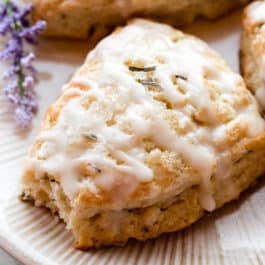Description
Using my favorite scones recipe, you can make bakery-style lavender scones right at home. They’re buttery and moist with crisp crumbly edges and soft flaky centers. Read through the recipe before beginning. You can skip the chilling for 15 minutes prior to baking, but I highly recommend it to prevent the scones from over-spreading.
Ingredients
- 2 cups (250g) all-purpose flour (spooned & leveled), plus more for hands and work surface
- 1/2 cup (100g) granulated sugar
- 2 and 1/2 teaspoons baking powder
- 2 teaspoons dried culinary lavender
- 2 teaspoons lemon zest
- 1/2 teaspoon salt
- 1/2 cup (8 Tbsp; 113g) unsalted butter, frozen
- 1/2 cup (120ml) buttermilk, plus 2 Tablespoons (30ml) for brushing
- 1 large egg
- 1 and 1/2 teaspoons pure vanilla extract
- optional: coarse sugar for topping
Lemon Lavender Icing
- 3 Tablespoons (45ml) heavy cream or milk
- 1 teaspoon dried culinary lavender
- 1 Tablespoon (15ml) fresh lemon juice
- 1 and 1/4 cups (150g) confectioners’ sugar
Instructions
- Whisk flour, sugar, baking powder, lavender, lemon zest, and salt together in a large bowl. Grate the frozen butter using a box grater. Add it to the flour mixture and combine with a pastry cutter, two forks, or your fingers until the mixture comes together in pea-sized crumbs. See video and photo above for a closer look at the texture. Place in the refrigerator or freezer as you mix the wet ingredients together.
- Whisk 1/2 cup buttermilk, the egg, and vanilla extract together in a small bowl. Drizzle over the flour mixture, then mix together until everything appears moistened.
- To make triangle scones: Pour onto the counter and, with floured hands, work dough into a ball as best you can. Dough will be sticky. If it’s too sticky, add a little more flour. If it seems too dry, add 1 more Tablespoon buttermilk. Press into an 8-inch disc and, with a sharp knife or bench scraper, cut into 8 wedges. For smaller scones, press dough into two 5-inch discs and cut each into 8 wedges. To make 10-12 drop scones: Keep mixing dough in the bowl until it comes together. Drop scones, about 1/4 cup of dough each, 3 inches apart on a lined baking sheet.
- Brush scones with remaining buttermilk and for extra crunch, sprinkle with coarse sugar. (You can do this before or after refrigerating in the next step.)
- Place scones on a plate or lined baking sheet (if your fridge has space!) and refrigerate for at least 15 minutes.
- Meanwhile, preheat oven to 400°F (204°C).
- Line a large baking sheet with parchment paper or silicone baking mat(s). If making mini or drop scones, use 2 baking sheets. After refrigerating, arrange scones 2-3 inches apart on the prepared baking sheet(s).
- Bake for 18-26 minutes or until golden brown around the edges and lightly browned on top. Larger scones take closer to 25 minutes. (Tip: I like to start the icing while the scones cook so the milk has a chance to steep.) Remove from the oven and cool for a few minutes before icing.
- Make the icing: In a small saucepan over low heat, bring the milk to a simmer. Remove from heat and immediately add the lavender. Set aside to steep for 15 minutes. Strain the milk through a fine-mesh sieve set over a bowl, then discard the lavender. Cool for 5 minutes. Whisk in the lemon juice and confectioners’ sugar. Feel free to add more confectioners’ sugar to thicken, if desired. Drizzle over warm scones. Icing can be made 1-2 days ahead and stored in the refrigerator.
- Leftover scones keep well at room temperature for 2 days or in the refrigerator for 5 days.
Notes
- Freeze Before Baking: Freeze scone dough wedges on a plate or baking sheet for 1 hour. Once relatively frozen, you can layer them in a freezer-friendly bag or container. Bake from frozen, adding a few minutes to the bake time. Or thaw overnight, then bake as directed.
- Freeze After Baking: Freeze the baked and cooled scones before topping with icing. I usually freeze in a freezer-friendly bag or container. To thaw, leave out on the counter for a few hours or overnight in the refrigerator. Warm in the microwave for 30 seconds or on a baking sheet in a 300°F (149°C) oven for 10 minutes.
- Overnight Instructions: Prepare scones through step 4. Cover and refrigerate shaped scones overnight. Continue with the recipe the following day.
- Special Tools (affiliate links): Glass Mixing Bowls | Box Grater | Pastry Cutter | Bench Scraper | Baking Sheet | Silicone Baking Mat or Parchment Paper | Pastry Brush | Citrus Zester | Citrus Juicer | Fine Mesh Sieve
- Over-spreading: Start with very cold scone dough. Expect some spread, but if the scones are over-spreading as they bake, remove from the oven and press back into its triangle shape (or whatever shape) using a rubber spatula.
- Lemon: 1 medium lemon is plenty for the zest and juice you need for this recipe (zest for the dough and juice for the icing).
- Buttermilk: You can substitute heavy cream for buttermilk if desired. Acidic buttermilk isn’t needed in order for the scones to rise since we’re using baking powder. However if you’d like the tangy flavor you can make your own sour milk substitute. Add 1 teaspoon of fresh lemon juice or white vinegar to a liquid measuring cup. Add enough milk to make 1/2 cup. Whisk together, then let sit for 5 minutes before using in the recipe. For the extra 2 Tablespoons needed for brushing on top of the scones, you can use regular milk or heavy cream. Whole milk is best for the DIY sour milk substitute, though lower fat or nondairy milks work in a pinch. (The scones will spread more if using lower fat or nondairy milks.)
